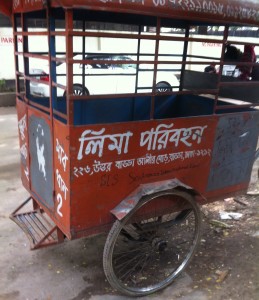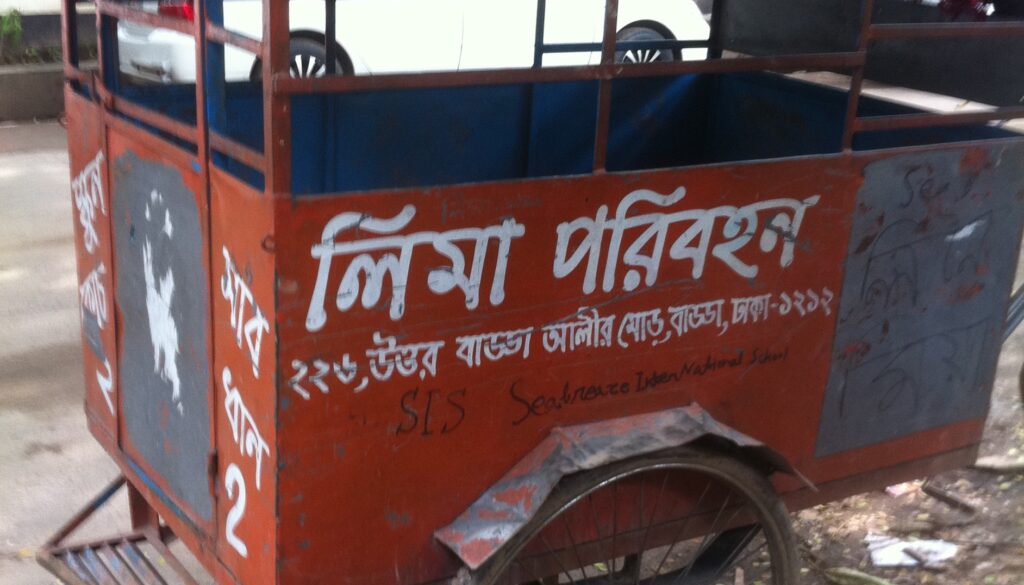Bangladesh Television, and Scripts Unseen

When I was in Bangladesh last week, meeting members of some of the country’s indigenous peoples and thinking a great deal about endangered alphabets, I found myself thinking about issues of script loss even in my down time—in other words, when I was watching television.
A naïve visitor to a developing country (or, indeed, any country) might assume that the channels on offer speak to that country’s cultural communities, and, by implication, speak in their languages. And even though not many people apart from me think in terms of scripts, the naïve visitor might likewise assume that those same TV channels will offer visual representation of those same local languages, as displayed in the scripts that appear on the screen.
At first sight this seemed to be true, because in flicking through the channels in search of live coverage of cricket matches and the Copa America, I saw a great of Bengali script (which, by the way, I can’t read). A closer channel-by-channel examination, however, even though hardly scientific, showed television to have less to do with the broadcast and expression of local culture and more to do with the forces of cultural and economic globalism.
The television in the guest house where I was staying boasted nearly 100 channels, though several of these were blocked, dysfunctional, or duplicates of other channels. In any case, for the purposes of this exercise I stopped my monitoring at Channel 40 because any developing country has a limited capacity to develop its own programming. Beyond 40, almost every channel was imported, mainly from the UK, the US and Australia. To be sure, these channels demonstrate that almost no country in the world can resist the infiltration of the English language and the Latin alphabet, but that wasn’t my point. I wanted to know to what extent that language and that script had already infiltrated and taken root.
With four channels in the Top 40 apparently duplicates, at least at the time when I was watching, this left 36 separate video/audio streams to examine.
So here’s my question. We all know the process by which one language is eroded and then marginalized by another. I was curious to see whether something similar was happening with scripts. Were the Bengali channels displaying exclusively Bengali script, or was the visual representation of Bengali similarly being infiltrated by the use of Latin script—and if so, under what circumstances?
Even before I started concentrating on the individual channels, I realized that the TV set itself was Latin-centric: when I used the remote to change channels, the channel numbers that appeared briefly were Latin numerals rather than Bengali. (That is to say, English Latin numbers, rather than Roman numerals.) The operation of a TV set, then, had an internationalized quality about it. TV was not only a window on the world, but a window through which the world could get in.
What’s more, the TV stations and channels themselves clearly saw themselves as operating in a broader world where the Latin script is essential: in every case but one, the station or channel ID logo in the corner of the screen used Latin letters and/or words. To be television, it seemed, was to be modern and international and therefore to use the Latin script, the global signifier.
At this point, I confess, I got distracted. (In case it’s not already clear, I have the instincts but not the training of a researcher. I don’t have a Ph.D., and would gnaw off my own leg rather than work through one.) In particular, I got distracted by the commercials—which are, after all, intended to distract.
It was clear right away that commercials as a whole, in appealing to the middle and upper classes with disposable income, almost invariably tried to present their products and services as cosmopolitan and modern, which in the case of imported products meant interjecting the English name (“Head and Shoulders”) and even English terms (“dandruff”) into the voiced-over stream of spoken Bengali, and preserving the names and labels in their original Latin script onscreen. To be hip and worldly in Bangladesh, it seemed, is to be able to speak English and read the Latin alphabet.
This looks unremarkable until you consider how weird it would look on American TV to hear the names of imported Japanese cars, or a thousand miscellaneous Chinese products, pronounced in Japanese or Chinese and with Toyota, say, represented onscreen in Japanese characters. A substantial percentage of the shrimp sold in the U.S. are imported from Bangladesh, in fact, but that doesn’t mean we need to know the Bengali word for “shrimp” to order them. We are clearly the bosses here, and language is simply one sign of that inequality.
The more commercial the content, the more English words appeared. Serious discussion programs on local and national affairs, and religious programs, were entirely in Bengali, from what I could tell. Once the channel broke to commercial, though, the rules changed. A voice on a channel otherwise entirely voiced in Bengali suddenly said “Crown Cement.”
The more upscale and cosmopolitan ads, especially those that seemed to have been made in India featuring Indian models, cricketers and movie stars, switched constantly and fluently into and out of English as a sign of their sophistication.
The same was even more true of texts. A glossy beauty-product or car commercial, voiced over half in English, was likely to present its text almost entirely in Latin script. The name and the label were the brand. Even low-budget ads produced for regional channels tended to have CALL NOW in English, with the phone number in both Latin and Bengali scripts.
Concentrating on the programming itself showed different kinds and different degrees of infiltration. One channel seemed to have audio consisting entirely of Bangla music. Of the other 35, 11 had audio in English (including HBO, which oddly also had subtitles in English). The other 24 had what I will call “regional audio” to disguise the fact that my ear can’t distinguish Bengali from, say, Hindi.
In these 24 channels clearly locally produced for local consumption, English words had certainly infiltrated the local spoken language. In general narrative, conversation or newscasts, it wasn’t unusual to hear “kilometer” or “twenty-eleven.” (The year, that is.) In broadcasts about cricket, of course, technical terms such as fielding positions or equipment were almost all in English.
What about texts? For some stations, their visual identity was entirely Bengali; in some cases, though, they seemed to have decided that a little internationalized pepping-up was in order. On at least two otherwise all-Bangla channels, program names (FRONT LINE, FASHION) were presented in English/Latin capitals.
I found the whole exercise slightly depressing, if unsurprising. At least in theory, television should be perfectly capable of acting in the name of cultural integrity. One of the people I met in Dhaka worked on the Bangladeshi incarnation of Sesame Street, and he was very aware of the goal of teaching children their letters and numbers in Bengali rather than some internationalized form.
In truth, though, TV in Bangladesh in 2011 behaves very much like TV in the U.S. in 1953: earnest local programming was already being edged out by glossier network programming, which seemed to come from a larger, brighter, more exciting world, a world without regional accents or dialects, a world of luxuries and affluence that seemed to have no geographic locus at all. Everywhere and nowhere.

